Tech Topic | March 2017 Hearing Review
In the past 15 years, research has suggested that people with hearing loss might benefit from either fast or slow compression depending on their cognitive status. This article reviews the concept of compressor speed and its possible relationship to cognitive capacity and also looks at how the Variable Speed Compressor (VSC) used in the BEYOND hearing aid may allow optimal speech understanding for people with all cognitive backgrounds.
In recent years, much attention was paid on how the cognitive ability of hearing aid wearers could affect the ease in which they decode processed sounds. In short, it has been suggested that people with cognitive limitations (or poor working memory) may yield better speech scores with slow-acting compression (SAC), whereas people without cognitive limitations (or good working memory) yield higher speech scores with fast-acting compression (FAC).1,2
These research findings have two potentially significant implications. First, hearing aids should be designed so that different signal processing strategies are used to account for individual differences. Second, information on individual differences—in this case, cognitive capacity—should be available to aid in the fitting of hearing aids.
Because the realization of these implications could drastically change the way hearing aids are dispensed, it is worthwhile to examine if a more pragmatic solution is available to meet the needs of people with different cognitive backgrounds. In this paper, we will review the concept of compressor speed and its possible relationship to cognitive capacity. We will then review how the Variable Speed Compressor (VSC) used in the BEYOND hearing aid, designed under the Effortless Hearing rationale,3 may allow optimal speech understanding for people with all cognitive backgrounds.
What Is Compression Speed?
All modern day hearing aids use some forms of compression in their signal processing. Compression has the stated advantages of providing more gain for soft sounds and less gain for loud sounds (than linear). However, how quickly this gain change occurs is critically important in determining the effectiveness of the compressor and the associated artifacts. An optimal speed should be responsive to changes in the sound environments, ensuring audibility and retaining all the necessary cues for the brain to process effortlessly.
The speed of a compressor is specified by its time constants. Two terms are important to differentiate:
- Attack time is the time it takes for the compressor to reduce its gain from the steady-state to within 3 dB of the new state. This occurs when the input stimulus exceeds the compression threshold (CT) of the compressor.
- Release time is the time it takes the compressor to return from the reduced gain state to within 4 dB of the normal steady gain state. This occurs when the input stimulus falls below the compression threshold of the compressor.
Figure 1 shows the waveform of an original stimulus and its compressed form to illustrate the concept of attack and release times. The part of the compressed signal that exceeds the steady-state signal is the overshoot, whereas the part of the compressed signal that is below the steady-state signal is the undershoot. These artifacts are unavoidable; however, they can be minimized.
Attack times can range from 0.5 ms to 2 s, although the typical cutoff for short attack time is below 10 ms. If one considers that the attack time is to transition from a high-gain state to a lower-gain state, a faster attack time has the advantage of a lowered output sooner. This could be beneficial from the perspective of subjective comfort. The release time can range from 5 ms to 20 s, although the typical cutoff for a short release time is <200 ms.4 The definition for a long release time is more variable, ranging from as short as 500 ms to as long as 20 s. If one considers that the release time is to transition from a lowered-gain state to a higher or normal-gain state, a faster release time has the advantage of a higher output sooner. This could be beneficial from the perspective of audibility for the subsequent sounds.
In theory, fast attack and release times are desirable. In reality, the co-existence of distortions and artifacts associated with a short time constant would suggest that it may not be acceptable to have a fixed short time constant at all times.
How Does the Time Constant Affect Perception?
Time constants are important to consider in a hearing aid because they affect audibility, the temporal envelope, and fine structures of speech sounds at all input levels. Audibility of sounds is obviously important for people with a hearing loss. Indeed, when there is no audibility, there can be no intelligibility.
The temporal envelope of sounds has been recognized as important for sound quality judgment.5 Recently, research has shown that the temporal envelope also affects speech intelligibility in situations where the contextual cues are low,6 for people with a severe hearing loss,7,8 and/or those with lower cognition.9,10 In these situations, temporal cues become indispensable for understanding.
Thus, one should recognize that perception is dependent on a multitude of cues—context, audibility, temporal envelope and fine structures, prior knowledge, and memory, to name a few. In an optimal situation where all the other cues are present, the absence of one set of cues (eg, contextual or temporal cues) may not significantly affect perception. On the other hand, in a sub-optimal situation where the available cues are already scarce, the impact of missing one cue (such as temporal) could be significant, especially for those with lower cognitive resources.
The Case for SAC
The choice of SAC and long time constants is to provide slow gain changes, so listening is at a comfortable level without the need for volume adjustment. An advantage of the slow gain change is better preservation of the temporal waveform than a FAC system.
Figure 2 illustrates how time constants may alter the final envelope. An input sound changing from 40 dB to 80 dB and followed by the same sound changing from 40 to 60 dB is presented. A stimulus peak-to-peak difference of 20 dB is noted in the original signal. Using the static I-O curve shown on the left, the amplified output still provides a peak-to-peak difference of 20 dB after compression. The blue line shows the dynamic or effective compression ratio of the system is reduced to close to 1:1 (or linear). In this case, a longer time constant has the advantage of better preserving the natural dynamics (or modulation characteristics) of the input waveform.5,7,11 In essence, it linearizes the processing for the affected input range. Kuk12 provided a rationale for the use of SAC as the main compression scheme for hearing impaired listeners.
The observation that SAC preserves the temporal waveform has important implications on the resulting sound quality and intelligibility:
- Short term changes within the envelope are less affected because of the slow change in gain. This results in a higher naturalness and better sound quality.5,11,13
- People with more than a moderate degree of hearing loss are more dependent on the temporal envelope cues for speech recognition. Thus, their speech perception scores with a SAC are higher than that of a FAC when audibility is ensured.7,8
- People with limited cognitive resources may use the preserved temporal cues for speech intelligibility purposes.6,14
- Because the relative levels of sounds are preserved in each ear, the natural inter-aural level difference—an important cue for sound localization—is preserved to allow for more accurate localization and spatial orientation. This could be helpful when communicating in a large, noisy environment where knowing the spatial location of the speaker helps understanding.
- In moderately noisy backgrounds, a SAC can also better preserve the relative difference in levels between the speech and noise backgrounds (ie, better signal-to-noise ratio) of the incoming sounds, making understanding easier than the case with FAC.13
There can be disadvantages in the exclusive use of SAC. Some sounds, especially softer ones presented after a louder sound (such as door slam or coming out of a loud party), may not be audible immediately. This is because the soft sound assumes the reduced gain of the louder sound and remains inaudible for some time. This may make the hearing aid appear silent or “dead” intermittently. Such limitation may be overcome with an increase in overall gain of the hearing aid. This can also be achieved with a low compression threshold15 to restore audibility of some soft sounds. Alternatively, the use of a FAC for soft sound inputs can better preserve audibility than SAC.7
The Case for FAC Figure 3 shows how short time constants (or FAC) affect the temporal envelope of the input signal. A comparison of the amplified softer level sounds between Figures 2 and 3 shows that the level of the softer sound reaches a higher level sooner in the FAC than in the SAC. This would suggest that the audibility of weak sounds following louder sounds is better represented. A short time constant ensures that the effective compression ratio (CR) is the same as the static one (blue line in Figure 3).
One the other hand, the same figure also demonstrates that the action of FAC reduces the peak-to-peak and peak-to-valley intensity difference from the 20 dB in the original signal to 10 dB in the compressed signal. This reduction in modulation depth has the following consequences on perception and speech intelligibility:
- Poorer sound quality rating of FAC processed sounds than SAC.5,11,13
- Ambient noise becomes more perceptible in quiet. During periods of speech, the silent pauses between speech segments are amplified and appear as a “pumping” sound.
- In moderate levels of background noise, the noise may be amplified more to reduce the speech-to-noise ratio. This could make speech understanding in background noise more difficult. This is especially so in multichannel hearing aids8 and/or in hearing aids with a high compression ratio.16,17 Together with the already poorer spectral resolution of the hearing-impaired ears, such smearing results in poorer speech intelligibility despite audibility advantages in people with more than a moderate degree of hearing loss.8,18 This also limits the practical CR to <3:1 and the number of independent compression channels in commercial hearing aids.
- Because FAC reduces intensity contrasts, the same sound received at the two hearing aids of a bilateral pair will have a smaller inter-aural level difference than in the case of SAC. This reduces the localization cues and may make spatial awareness and localization more difficult.
As indicated in Figure 3, the use of FAC preserves the static CR, but a higher CR will likely degrade the temporal envelope. Thus, one way to minimize the impact of FAC is to use it with a lower CR. Another possibility is to use it with a broader bandwidth (ie, fewer compression channels). The last option is to use FAC only for softer sounds where audibility may be more critical, and to use SAC at all other input levels.
How Is Compression Speed Tied to Cognitive Ability?
In the last 15 years, much research has examined how a fixed compression speed (time constants) affects people with different cognitive abilities. Gatehouse et al19 reported in 2003 that hearing-impaired subjects with a poor working memory performed better on a speech recognition test when stimuli were processed with a fixed, long time constant; on the other hand, individuals with a good working memory did better when the test materials were processed with a shorter time constant. Similar findings were replicated by researchers from that same group,1,2 as well at other labs.6,14 Furthermore, other researchers also reported improvement in speech recognition by enhancing the temporal envelope of speech for individuals with auditory neuropathy (or auditory neuropathy spectrum disorder).20
Results of these studies led some to suggest that SAC may be used for people with a poor working memory, whereas FAC may be used for people with a good working memory. This means hearing aid signal processing would need to tailor to the individual’s specific cognitive needs (and probably psychophysical needs also).
By extension, this also implies that dispensing professionals should know the cognitive ability of the potential wearer so the right form of signal processing is applied. This certainly seems like the right direction; however, it could indicate a sea change in how hearing aids are to be designed and fit. Thus, before such an implementation, it is necessary to determine if the data reflect such a reality and if there are other easier means to circumvent the limitations.
Do the Data Make the Right Inference?
There are two important points to remember:
- Whether the wearers have a good or poor working memory, they need the signal to be audible before they can detect and understand the sounds. That means audibility is equally important for people who have poor working memory or good working memory.
- The temporal structure of the sounds is important in the “naturalness” and “sound quality” of the sounds. It also carries supra-segmental (including emotional) and intelligibility cues. That means temporal information is also equally important for people with good working memory or poor working memory.
Both of these factors (audibility and temporal) play an important role in the perception of these sounds and both must be provided to all hearing aid wearers. However, the reliance on each may vary depending on the cognitive state of the individuals.
For people with a good working memory, having audibility of the sounds ensures that the sounds can be identified. FAC can achieve this audibility, although at the expense of potentially distorting the temporal structures. On the other hand, people with a good working memory may be more resistant to the effect of temporal distortion; thus any temporal distortion may only affect the sound quality but it does not affect its identification. SAC may result in the absence of some audibility cues despite a natural temporal waveform, with the possible result of poorer performance when compared to fast acting compression for people with good working memory.
People with a poor working memory are reliant on both the audibility and temporal cues for speech identification. When audibility cues are provided using FAC, the distortion/smearing in the temporal cues may have made the availability of the audible signals unusable. On the other hand, the use of the SAC, despite missing some audible cues, may still keep the temporal cues intact and make the processed sound usable. Thus, people with poor working memory perform better with SAC than FAC. This does not mean that audible cues are not helpful; just audible cues made available at the expense of a distorted waveform (or distorted temporal cues) are not easily usable because of their working memory limitation. The interaction between working memory and compression speeds may be summarized in Figure 4.
The above discussion suggests that, while audibility is important, audibility achieved at the expense of temporal distortion could have different consequences to people with good versus poor working memories. This view is different from the view that people with good working memory are better served with FAC and people with poor working memory are better served with SAC. Indeed, it suggests that both groups of individuals can be best served by the same form of compression as long as the compression achieves the same audibility without any temporal distortion.
If this form of compression can be achieved, the need for individualizing compression speed based on cognitive backgrounds may be unnecessary.
Means to Overcome Limitations
The published research studies on cognition and compression speed used fixed time constants that are labeled as either “long” or “short.” While these studies can shed light on how compression speed may interact with cognitive capacities, they do not reflect what is (or can be) implemented in commercial hearing aids. In reality, manufacturers have implemented various strategies that incorporate the benefits of SAC and FAC. Indeed, it is likely that a single, more complex compression scheme can achieve temporal integrity while achieving audibility (ie, without individualizing compression speeds).
Previously Kuk12 provided a rationale for SAC with the observation that the residual dynamic range of most people with hearing losses less than 70 dB HL are broader than the dynamic range of sounds occurring in any listening environments and at any one vocal effort. That is, hearing-impaired listeners with less than a severe degree of hearing loss can receive linear processing at any instance without any distortion of the input signal. To transition gain from one listening environment to another, or from one vocal effort to another, SAC may be used. This preserves the linearity of the input waveform, while introducing the least amount of temporal distortion to the input signal.
To overcome the limitations from a rapid transition between listening environments, one approach is to primarily use SAC as the main compression speed, and change the compression speed to fast as the listening situation demands in order to achieve the audibility requirement. This way, the temporal waveform is preserved most of the time, and extra audibility can be ensured when it is needed. This would benefit people with good and poor working memories so hearing (and listening) for all is effortless.
If so, there is no need to determine the individual’s cognitive state for the purpose of fitting compression hearing aids, nor is there a need to design hearing aids that allow individualization of compression speeds. However, it does not mean individualization based on other considerations may not be necessary.
A Variable Speed Compressor (VSC)
One approach is the use of both fast-acting and slow-acting compression in the same hearing aid, but let each dominate the overall processing depending on the listening situation. This is the case of the new BEYOND Variable Speed Compressor (VSC) system, where two compressors in each channel—a slow-acting compressor and a fast-acting compressor—work in parallel to determine the final output from each channel. In addition, a system that facilitates rapid gain change from a sudden change in input levels (a JUMP system) is also included.
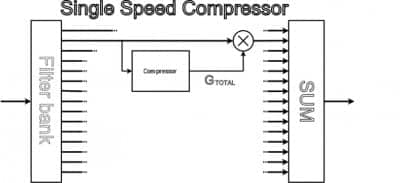

Figure 5. Functional block diagram of a classical single speed compression system (upper) and the Variable Speed Compressor (lower) used in the BEYOND hearing aid. This shows the overall output from filter channel #2. It indicates that the overall output is the sum of the SAC from channel #2, and the FAC output from channel #2, which is made up of the average FAC output from channels #1, #2, and #3.
Slow Compressor
Figure 5 shows a functional block diagram of the two parallel compressors in the BEYOND hearing aids for one frequency channel. The slow-acting compressor estimates gain based on the degree of hearing loss, the choice of the prescriptive target, and an estimation of the level of the input signal. Changes in the compression parameter (such as compression ratio) will change the assigned gain. It provides slow gain regulation to control the overall level of the output signal. Figure 6 shows the stimulus and the associated gain assignment by the SAC to that signal. One can see that although the speech signal changes quickly (over a 40 dB range), the SAC gain does not change as much (less than 10 dB).

Figure 6a-b. Input amplitude (upper) and the associated gain (lower) by the slow compressor over time
Fast Compressor
The fast compressor uses a much shorter time constant than the SAC system. It follows the dynamic (intensity) changes of the input signals (ie, modulation) at all input levels to augment the gain provided by the slow compressor. Compared to a slow compressor, gain fluctuation is much more rapid over time. Figure 7 shows the gain changes with the same input signal over time in a single-speed fast compressor.
In the BEYOND VSC system, gain provided by the FAC varies with the difference in output level between the FAC and the SAC. The overall gain provided by the hearing aid is the sum of the gain prescription by the SAC and the FAC. Figure 8 shows the fast gain and the slow gain, along with the total gain provided by the VSC over time for the same sentence used in Figure 6. Such gain characteristics allow the compressor to keep up with the fast dynamics of the speech signal while keeping the temporal integrity.
On the other hand, it was indicated previously that a potential problem of FAC is that it changes the temporal and spectral contrasts of the input signals, and may cause background noise to become more audible during speech pauses. This can result in a poorer sound quality than with slow-acting compression. To minimize the negative impact of the FAC, we implemented the following design elements in the VSC system:
- Use FAC only in quiet or when the SNR is favorable. It is easy to imagine that the negative effect of FAC will only be realized if the temporal waveform is sufficiently distorted. In that case, if the input has a high SNR or when the environment is quiet, a small amount of fast-acting compression may not affect the temporal waveform enough to degrade sound quality and/or speech intelligibility. However, if there is already some level of noise in the background (ie, poor SNR), FAC will add more gain to the noise and further reduce temporal contrast. One can safeguard against the use of FAC gain by knowing the SNR of the situation. In the BEYOND, a “modulation” control is used to estimate the SNR of the situation and to determine if FAC gain should be included. The rationale is that signals which show a high degree of modulation (eg, speech in quiet) may withstand more fast-acting compression before a consequential degradation occurs. Input signals that show little modulation (such as speech in noise) may not be able to withstand as much fast compression because of the already reduced modulation. Thus, FAC will only be applied in the “quiet” situation or in situations where the modulation depth is high (good SNR), while SAC is used in most situations including difficult ones (such as noise) to minimally disturb the temporal waveform.
- Linking nearby channels. Another implementation to minimize any spectral distortion with FAC is to link the processing of the fast-acting system to a broader bandwidth. Hau and Andersen21 showed a broader bandwidth decreases the amount of potential smearing artifacts than a narrower bandwidth. In the BEYOND VSC, the FAC performs its individual level estimation in each of the 15 channels. However, the combined actions of the nearby bands (ie, one above and one below) are taken into account when calculating the fast gain variations. This is seen in the block diagram shown in Figure 5. This minimizes any potential smearing to ensure good sound quality while improving audibility.
- Maintain a low effective compression ratio. A third control is to use a low compression ratio (CR). This is because the negative effect of FAC diminishes with a lower CR.21 While the static compression ratios used in the BEYOND is the same as that of the DREAM, the various actions (such as inclusion of nearby channels) maintains a lower effective compression ratio at a high input level.
- User specific. While people with up to a moderately severe hearing loss can take advantage of the audibility benefit provided with FAC in highly modulated conditions, those with more than a severe loss cannot. This is because people with a severe hearing loss (>75 dB HL) are more dependent on the temporal waveform.7 Thus, in this hearing aid system, people with up to a moderate degree of hearing loss receive gain that is the sum of FAC and SAC. People with more than a moderately severe loss will receive gain primarily determined by the SAC, and/or gain determined with a low CR.
Benefits of the VSC
The implementation of the variable speed compressor in the BEYOND provides more audibility for soft sounds and a more natural waveform for loud sounds over the current adaptive compressor design used in the DREAM. This suggests wearers with a mild-to-moderate loss will have more audibility of soft speech with the BEYOND than with the DREAM. They may also experience better sound quality at a high input level. There may not be much difference between the two compressors for conversational sounds. On the other hand, those with a more severe hearing loss will have an even better preserved temporal waveform with the new system at high input levels. Improved speech intelligibility in quiet and in noise, as well as better sound quality, may be expected.
In order to evaluate the effectiveness of the VSC over the single adaptive compressor (ie, DREAM), a double-blind study was conducted on 18 mild-to-moderate hearing impaired subjects comparing their performance between the UNIQUE hearing aid (a predecessor of the BEYOND) and the DREAM hearing aid matched to the same output. Subjects were tested using the ORCA-NST nonsense syllables presented at a 50 dB SPL. To simulate the condition of loud speech followed by soft speech, the carrier phrase of the ORCA-NST (“Please say the word…”) was presented at an 80 dB SPL level, to be followed by the target nonsense syllable at 50 dB SPL. All stimuli were presented in the sound field directly in front of the bilaterally aided subjects.
The resulting phoneme (consonants and vowels) scores are shown in Figure 9 and shows that subject performance was clearly better with the UNIQUE than the DREAM in 15 of the 18 subjects tested. An average improvement of 4.3 percentage points was noted on consonant identification. This reflected a 7.3% improvement in performance over the baseline score. The benefit was especially notable in the word final position, where a 4.7% point improvement (or 29.6% improvement relative to the baseline) was reported. In particular, improvements with the final stop consonants (8.9 percentage points or 72.7% relative to the baseline), and especially the unvoiced final stop consonants (9.3 percentage points or 100% improvement relative to the baseline) were remarkable.
Conclusions
Widex is the first to introduce and advocate the use of long time constants with the SENSO in 1996 in order to consistently provide good sound quality and speech intelligibility. This advantage has continued into the BEYOND hearing aid with VSC that is designed to be even more effective in preserving audibility of soft sounds and temporal cues than the DREAM.
Considering that people with a good working memory can utilize audible cues even with a slightly distorted temporal cue, the output from the VSC should provide the needed audibility for these individuals with a better sound quality when compared to a single speed compressor. Considering that people with poor working memory would have to miss the audible cues in order to get the temporal cues (from SAC), the VSC in the BEYOND offers them the extra audibility without sacrificing temporal cues. Thus, the VSC could be beneficial to people with good and poor working memory.
This again reinforces our design rationale of Effortless Hearing3 where every feature on the hearing aid is designed so hearing-impaired individuals—regardless of cognitive capability—would find it the least effortful to hear and communicate in all listening situations.
 References
References
-
Gatehouse S, Naylor G, Elberling C. Linear and nonlinear hearing aid fittings: 2. Patterns of candidature. Int J Audiol. 2006; 45(3):153-171.
-
Lunner T, Sundewall-Thoren E. Interactions between cognition, compression, and listening conditions: effects on speech-in-noise performance in a two-channel hearing aid. J Am Acad Audiol. 2007;18(7):604-17.
-
Kuk F. Going Beyond: A testament of progressive innovation. Hearing Review. 2017;24(1)[Suppl]:3-21. Available at: https://hearingreview.com/2017/02/going-beyond-testament-progressive-innovation
-
Dillon H. Compression? Yes, but for low or high frequencies, for low or high intensities, and with what response times? Ear Hear. 1996;17(4):287-307.
-
Hansen M. Effects of multi-channel compression time constants on subjectively perceived sound quality and speech intelligibility. Ear Hear. 2002;23(4):369-380.
-
Cox R, Xu J. Short and long compression release times: speech understanding, real-world preferences, and association with cognitive ability. J Am Acad Audiol. 2010;21(2):121-138.
-
Davies-Venn E, Souza P, Brennan M, Stecker G. Effects of audibility and multichannel wide dynamic range compression on consonant recognition for listeners with severe hearing loss. Ear Hear. 2009; 30(5):494-504.
-
Souza P, Jenstad L, Folino R. Using multichannel wide-dynamic range compression in severely hearing-impaired listeners: effects on speech recognition and quality. Ear Hear. 2005;26(2):120-131.
-
Souza P. Older listeners’ use of temporal cues altered by compression amplification. J Speech Hear Lang Res. 2000;43(3): 661-674.
-
Jenstad L, Souza P. Temporal envelope changes of compression and speech rate: combined effects on recognition for older adults. J Speech Lang Hear Res. 2007;50(5):1123-1138.
-
Neuman A, Bakke M, Mackersie C, Hellman S, Levitt H. Effect of release time in compression hearing aids. J Acoust Soc Am. 1995;98(6): 3182-3187.
-
Kuk F. Rationale and requirements for a slow acting compression hearing aid. Hear Jour. 1998;51(6):45-53, 79.
-
Neuman A, Bakke M, Mackersie C, Hellman S, Levitt H. The effect of compression ratio and release time on the categorical rating of sound quality. J Acoust Soc Am. 1998;103(5:1) 2273-2281.
-
Souza P, Sirow L. Relating working memory to compression parameters in clinically fit hearing aids. Am J Audiol. 2014;23(4):394-401.
-
Kuk F. Optimizing compression: the advantages of a low compression threshold. In: Kochkin S, Strom KE, eds. High Performance Hearing Solutions, Part III: Marketing and Technology. Hearing Review. 1999; 6(1)[Suppl]:44-47.
-
Plomp R. The negative effect of amplitude compression in multichannel hearing aids in the light of the modulation-transfer function. J Acoust Soc Am. 1988;83(6):2322-2327.
-
Boike k, Souza P. Effect of compression ratio on speech recognition and speech-quality ratings with wide dynamic range compression amplification. J Speech Hear Lang Res. 2000;43(2):456-468.
-
Bor S, Souza P, Wright R. Multichannel Compression: Effects of Reduced Spectral Contrast on Vowel Identification. J Speech Lang Hear Res. 2008; 51:1315-1327. doi:10.1044/1092-4388
-
Gatehouse S, Naylor G, Elberling C. Benefits from hearing aids in relation to the interaction between the user and the environment. Int J Audiol. 2003;42[Suppl 1]:S77-85.
-
Narne V, Vanaja C. Perception of envelope-enhanced speech in the presence of noise by individuals with auditory neuropathy. Ear Hear. 2009;30(1):136-142.
-
Hau O, Andersen H. Hearing aid compression: Effects of speed, ratio and channel bandwidth on perceived sound quality. April 2, 2012. Available at: http://www.audiologyonline.com/articles/hearing-aid-compression-effects-speed-770
Citation for this article: Kuk F, Hau O. Compression speed and cognition: A variable speed compressor for all. Hearing Review. 2017;24(3):40-48.
CORRESPONDENCE can be addressed to HR or Dr Kuk at: [email protected]


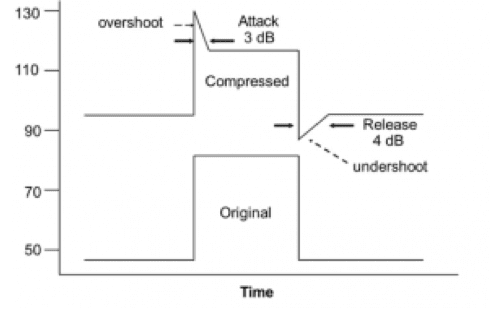

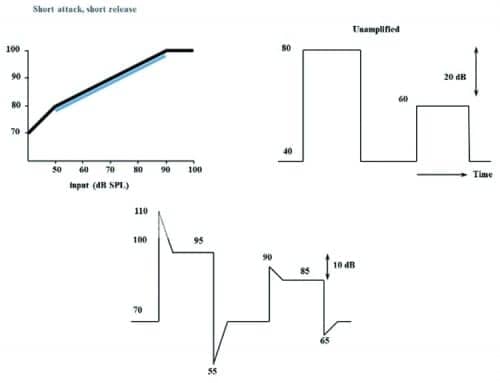

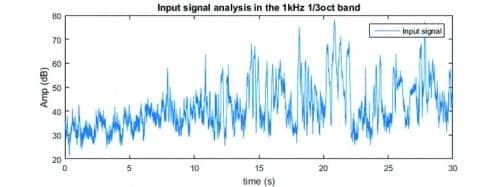

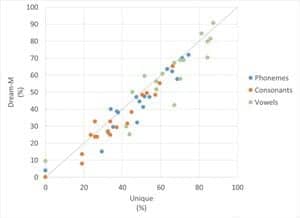

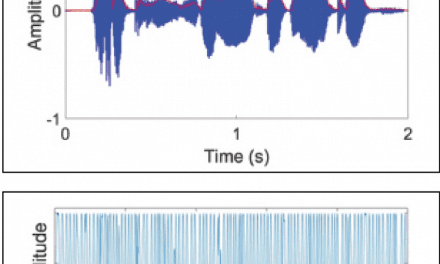

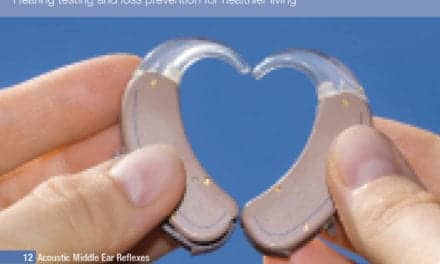

Please read my short and easy paper about real narrow bandwidth speech.
https://docs.google.com/document/d/e/2PACX-1vQsWHvHBz6Jljgjl24UlcFI6O2p8Kd-2HLoxXdwY53aF8ZXUa6AZIr7wJHotnOxd_-lDGuTTmSgZqIg/pub
The speed of a synaptic release is 2 ms. This has nothing to do with the content of stimulus.
Speech identification and recognition takes place cognitively, after the data is compared with long term memory. This means that storage and retrieval of speech memory is totally essential to processing the synaptic transmission. If there is no data available, then there can be no recognition. However if the transmission is corrupt, then the brain can figure out ways to arrive at “closest meanings”. Hearing loss does not affect the speed of synaptic transmissions, but does affect the processing time. If the signal is coming in at a slower rate than normal , due to SAC, then it could help in giving cognition the recovery and action time enough to deal with understanding. But maybe an increase from 2ms to maybe 5 ms. Anything more would confuse the brain.
That thinking is correct from a uni-dimensional neurophysiological perspective. Indeed, that perhaps was the theoretical rationale for FAC. In practice, the problem is that the brain also takes information over a period of time (i.e., temporal envelope cues) as a cue for recognition. That dependence increases as the degree of hearing loss increases, and as cognition decreases.